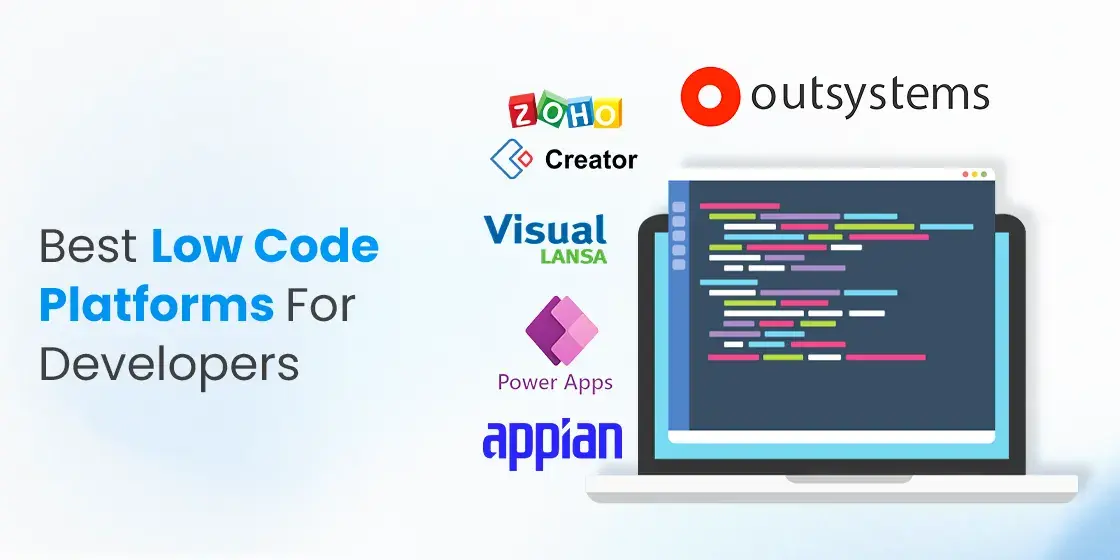Great Ideas For Selecting application development with Low-code platforms
The Ease Of Use Of Low-Code Apps Is Among The Major Advantages.Due to several factors the development of low-code applications is more accessible to non-developers. These are sometimes referred to as "citizens developers."
Drag-anddrop Builders: Lowcode platform include drag-anddrop interfaces to allow nondevelopers to visually create applications, without needing code. This allows development to be easier for people with backgrounds in technology.
WYSIWYG Editors: "What You See Is What You Receive" editors let users design interfaces and workflows in an approach that is similar to the final product, making it simpler to comprehend and use.
Simple Logic and Workflow:
Visual Workflow modeling: Users design business flows and application logic using visual flowcharts. These models are simpler to work with than traditional method of programming.
Logical Components Pre-built: Many low-code platforms come with pre-built components for logic (e.g. loops, conditions), that can be easily configured. This means that there is no necessity to write complicated programs.
Reusable Components and Templates:
Libraries of Templates that are pre-built A lot of platforms that allow low-code come with a library of template types that are suitable for most applications. This lets developers start quickly and efficiently, while non-developers can customize the templates however they see the need.
Reusable Widgets And Modules: Users can use reused widgets. This allows for a simpler creation and reduces the need of in-depth knowledge.
Tutorials and Guided Development
Step-by-Step guides: Platforms provide tutorials and on-screen help to non-developers who are building applications.
Interactive Tutorials Interactive tutorials are interactive and hands-on, which help users to learn through doing. This increases the confidence of users in the platform.
Integration with Existing Tools:
Easy Integration - Low-code platforms can easily be integrated with existing systems and tools for business (e.g. ERP CRM), allowing even non-developers to build apps that are compatible into their workflows.
APIs and Connectors : APIs built-in and connectors let users and non-developers to connect their applications to external services, without the need for complicated programming.
Collaboration Features:
Team Collaboration - Features like real-time team collaboration and shared workspaces allow non-developers to collaborate effectively with professionals, developers, analysts, and others.
Access Control Based On Roles: Non-developers can be assigned roles and access levels that allow them to contribute without compromising security or functionality.
Automated Testing, Debugging and Debugging
Built-in Testing Tools: Low-code platforms often include built-in testing and debugging tools that automate these processes, making it easier for non-developers and users to ensure that their apps function properly.
Error-highlighting: The platform provides information on issues and suggestions to help non-developers.
The general rule is that low-code app development can open up development to a wider audience. This is a significant benefit for those who aren't developers. Low-code applications allow business users to participate actively in the development and maintenance of applications by providing intuitive visual tools as well as a guiding user experience. This is a bridge between technical implementation and business demands. See the top wavemaker.com coding for more tips including app development platform, jdbc server, rad development, application modernization software, developing mobile apps, ms azure sql, develop web app, paas service, app dev platform, sso azure and more.

Benefits Of Low-Code Application Development With Respect To Governance And Security
Low-code application development offers several advantages in terms of security and governance, both of which is essential to ensure that applications are compliant and secure. They also ensure that they are well-managed throughout their entire life cycle. Here are the most significant benefits: Centralized Governance:
Unified Manage Console: Lowcode platforms usually have a management console which allows administrators to oversee and manage applications.
Role-Based Access Control RBAC (RBAC). These platforms typically have robust access control that is that is based on roles, giving administrators to create and enforce their own access policies. This ensures that only authorized users are able to access or modify certain areas of an application.
The Compliance Process and Regulatory Adherence:
Many low-code platforms come with built-in compliance features. These are designed to ensure that applications comply with industry standard (e.g. GDPR, HIPAA). They offer frameworks and tools to ensure that applications comply with specifications.
Audit Trails and Logging: Audit trails, comprehensive logging and logs are usually integrated into companies that allow them to keep track of changes and track access. They can also verify compliance with internal and outside regulations.
Improved Security Measures:
Data encryption: Low-code platforms generally provide encryption built-in for data in transit and while in transit, making sure that sensitive information is protected.
Security Certificates: Many low-code providers have a security certificate (e.g. ISO 27001 and SOC 2) which demonstrate that they are adhering to strict security standards. They provide an additional security level to their clients.
Automated updates to ensure security:
Regular updates and patches: Low code platforms typically are equipped to handle security patches and updates regularly. This ensures that applications remain protected from the latest threats without the need for developers to manually alter their settings.
Security Monitoring: Continuous security monitoring tools can be used to send real-time notifications and information on security issues.
Data Governance
Data Access Policies: These systems enable companies to establish and enforce policies regarding data access which ensure that data is only accessible only to those who have been granted access and used appropriately.
Data Masking, anonymization, and Anonymization Tools: These tools assist to secure sensitive personal information and are especially useful in testing environments.
Continuous application lifecycle management
Pipelines for development and deployment: Low code platforms offer integrated development and deploy pipelines that contain security inspections. These ensure that security is maintained through the entire application lifecycle.
Version Control: The integrated version control allows for the management of modifications and makes sure that modification to the application are identified and changed if necessary, maintaining the integrity of the application.
User authentication authorization
Single Sign-On - Support for single sign-on (SSO), and other advanced mechanisms of authentication, simplifies management and increases security.
Multi-Factor Authentication A lot of platforms have integrated multi-factor authentication, which adds an extra layer of security for accessing applications.
Monitoring of Policy Enforcement
Low-code platforms often come with pre-defined policies templates that enable organizations to implement cybersecurity and governance policies quickly.
Compliance Monitoring Tools: They provide continuous monitoring and report on compliance status. This helps to identify potential issues and address them proactively.
Integration with Existing Security Infrastructure:
seamless intergration: Low code platforms are designed to facilitate seamless integration with the existing security tools and equipment, including Identity Management Systems SIEM Solutions (Security Information and Event Management), and Firewalls.
API Security API Security: API security features are built-in to ensure integrations with external systems, securing information and ensuring integrity of the applications.
Training and Best Practices:
A lot of platforms provide guidelines and best practice for secure application development. They help non-developers comply with security standards.
Some low-code providers provide security education to help users learn how to develop and maintain secure applications.
Low-code development provides a variety of benefits for governance and security that ensure applications are developed and maintained in a timely safe and secure manner. These platforms provide the frameworks and tools necessary to safeguard sensitive information and enforce policies while maintaining the regulatory compliance. Check out the top Legacy application modernization with Low-code hints for site recommendations including push alerts, app modernisation, cross platform mobile development, build with docker, cross platform mobile dev, app platforms, build with docker, developing mobile apps, developing mobile apps, paas service and more.

Benefits Of Low-Code Application Development In Collaboration And Workflow
It's a great option for companies looking to boost team productivity as well as streamline processes and enhance collaboration. Here are a few of the main benefits: Improved cross-functional collaboration:
Unified Development Environment: Low-code platforms provide a single, unified environment in which all team members such as business analysts, developers designers, and other stakeholders are able to collaborate effectively. This removes the silos.
Visual Development Tool: The drag-anddrop nature of platforms that utilize low-code technology makes it easy for team members who aren't technical to be involved in the process of development. They can make sure that the business's requirements are precisely analyzed and implemented.
Communication Enhancement:
Real-Time Collaboration: A lot of low-code platforms provide real-time collaboration options including the simultaneous editing of comments and instant feedback. These features enable continuous communication and cut down on the time spent on back-and-forth discussions.
Shared workspaces. Teams are able to collaborate on shared workspaces. Here, they can view, edit and debate various project elements.
Streamlined Workflow Management:
Project management tools that are built-in Low-code platforms are often equipped with project management tools integrated that allow teams to plan, track and oversee their projects. This includes assignment of tasks, tracking progress, deadline management and much more.
Workflow Automation: Automating repetitive tasks and workflows will reduce errors and efforts, allowing the team to concentrate on more strategic work while increasing efficiency.
Speedier Iteration Cycles:
Rapid Prototyping: Platforms that use low-code facilitate quick prototyping and iterative development which allows teams to create tests, refine, and test applications with shorter time. This allows for rapid feedback and further improvement.
Agile Development Support: Supporting agile methods allows teams and individuals to work in smaller increments. This allows them to swiftly adapt to changes.
Accessibility for non-Developers
Citizens Development: Lowcode platforms permit people who use business software (citizen developers) to develop modifications, maintain, and create applications without extensive code knowledge. This alleviates the burden of IT and development teams and can provide faster responses to business needs.
Training and Onboarding – Intuitive interfaces, comprehensive training materials and user-friendly interfaces make it simple to help new members get familiar with the system and enhance the overall team's cooperation.
Centralized Documentation and Knowledge Sharing
Integrated Documentation: Low-code platforms usually include features to maintain and create documents within the platform, ensuring that all project data is accessible and centrally stored.
Knowledge Repositories : Teams can build knowledge repositories that contain templates, best practices, and reuseable components. This helps in sharing knowledge and helps reduce duplication of effort.
Consistency & Standardization
Standardized Components: The use of already-built, standardized components gives consistency between applications. It makes it easier for team members to grasp the different components of a specific project and to work on these components.
Governance and Compliance - Built-in governance frameworks make sure that the creation of every application follows organizational standards as well as regulatory standards. This helps reduce risks of non-compliance as well as ensure that the applications meet high-quality standards.
Feedback and Improvement
Integrated Feedback Low-code platforms offer users with feedback mechanisms integrated into them that enable them to provide easy feedback on applications. Feedback from users can later integrated into the application development process.
Continuous Improvement: The capacity to quickly test and implement changes in response to feedback ensures continuous improvement of the applications. They are in close alignment with the needs of users and goals of the business.
Visualization, Reporting and Analysis
Real-Time Analyses: The built-in reports and analytics tools offer immediate insight into project's performance, development and user interaction, allowing for data-driven decisions.
Visual Workflow Mapping Visual tools that visualize workflows and processes can help teams optimize their workflow by identifying bottlenecks.
In terms of collaboration, low-code software is an excellent way to simplify workflows, bring diverse teams together and streamline tasks. This results in a more flexible, collaborative and productive developing environment that produces better-quality applications.
